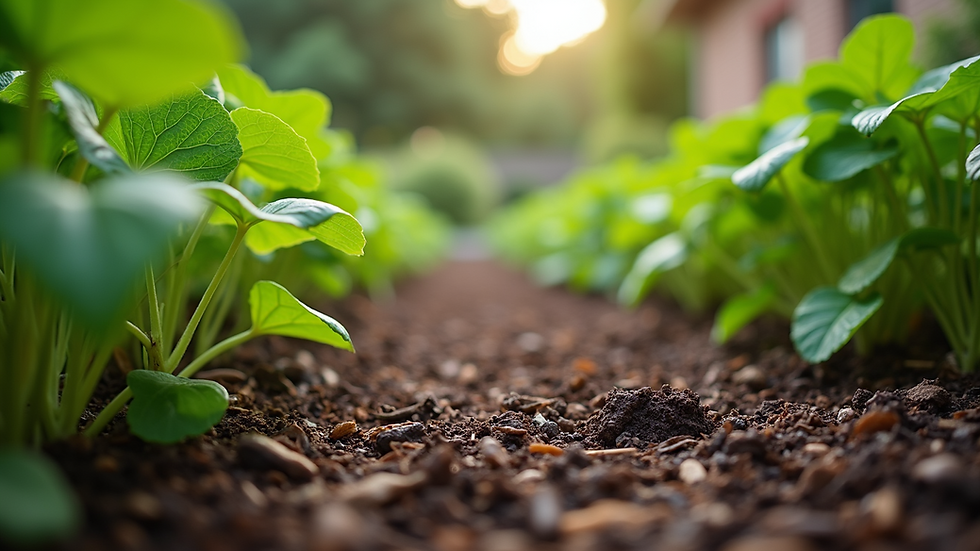Unveiling the Benefits of No-Till Gardening
- Admin

- Oct 7
- 4 min read
Have you ever wondered if there’s a gentler, more natural way to tend your garden? One that respects the soil, saves time, and nurtures life beneath the surface? Well, I’ve discovered something truly amazing: no-till gardening. It’s a method that’s changing the way we grow plants, and I’m excited to share the no-till gardening benefits with you!
No-till gardening is all about working with nature, not against it. Instead of digging and turning the soil, you let it be, allowing earthworms, microbes, and roots to do their magic. This approach has transformed my garden into a thriving, resilient ecosystem. Let me take you through the wonderful world of no-till gardening and why it might just be the best thing you can do for your garden.
Why No-Till Gardening Benefits Your Soil and Plants
One of the biggest no-till gardening benefits is how it improves soil health. When you stop tilling, the soil structure stays intact. This means the tiny tunnels made by earthworms and roots remain open, allowing air and water to flow freely. Healthy soil is the foundation of a healthy garden!
Tilling can disrupt these natural pathways and harm beneficial organisms. But with no-till gardening, the soil life flourishes. Microbes break down organic matter, releasing nutrients slowly and steadily. This natural nutrient cycling means your plants get what they need without chemical fertilizers.
Another fantastic benefit is moisture retention. Untouched soil holds water better, reducing the need for frequent watering. This is a huge win, especially during dry spells. Plus, no-till gardens tend to have less erosion because the soil stays covered with mulch or plant residues.
Imagine a garden where plants grow stronger, roots dig deeper, and the soil stays rich and alive year after year. That’s the magic of no-till gardening benefits in action!

How No-Till Gardening Benefits the Environment and You
Beyond your garden, no-till gardening benefits the environment in powerful ways. By not disturbing the soil, you reduce carbon release into the atmosphere. Soil is a major carbon sink, and keeping it intact helps fight climate change. Isn’t it amazing that your garden can be part of the solution?
No-till gardening also reduces runoff and pollution. When soil is tilled, rain can wash away nutrients and pesticides into nearby waterways. But with no-till, the soil stays put, protecting local streams and rivers. This means cleaner water and healthier ecosystems around your home.
For you, this method means less work and less expense. No heavy digging, no expensive equipment, and fewer inputs like fertilizers and pesticides. It’s a win-win for your wallet and your back!
Plus, no-till gardening encourages biodiversity. Beneficial insects, birds, and soil organisms find a welcoming habitat. This natural pest control reduces the need for chemicals, making your garden safer for kids, pets, and pollinators.

How do you start a no-till garden?
Starting a no-till garden might sound tricky, but it’s actually quite simple. The key is to stop disturbing the soil and start building it up naturally. Here’s how I began, and you can too:
Choose your spot - Pick a garden area that gets enough sunlight and has decent drainage.
Cover the soil with layers of organic materials, such as straw, leaves, grass clippings, and compost. This mulch protects the soil and feeds it as it breaks down.
Planting - Pull the mulch back to expose the bare soil, run your string line to create straight rows, and use a hoe or a sharpened stick to create a channel or hole to deposit the seed. Place the seed and cover. Once your crop begins to sprout, you will see where they are due to the straight rows. This helps with plant management using the chop-and-drop method of thinning unwanted plants.
Add compost regularly - Top dress your garden with compost to keep nutrients flowing.
Let nature do the work - Earthworms and microbes will aerate and enrich the soil naturally.
It’s essential to be patient. No-till gardening is a long-term commitment, but the rewards are worth it. Over time, you’ll notice healthier plants, less work, tastier produce, and a garden that is alive and thriving.
If you want to dive deeper, check out resources and tips from Earth Is Our Home Environmental Solutions. They offer fantastic guidance on sustainable gardening practices.

Practical Tips to Maximize No-Till Gardening Benefits
To get the most out of your no-till garden, here are some practical tips I’ve learned along the way:
Use diverse cover crops: Planting legumes, clover, or ryegrass helps fix nitrogen and protect the soil year-round.
Rotate crops: Changing what you grow in each bed prevents pests and diseases from building up.
Avoid chemicals: Use mulching, compost, and fermented plants to supply organic matter and nutrients to the system.
Water wisely: With cover material on the soil and plant diversity, water is held in the system more efficiently. Learning to identify the proper amount comes with practice and experience.
Observe and adapt: Watch how your garden responds and adjust your mulch layers, planting times, and watering accordingly.
Remember, no-till gardening is about working with nature’s rhythms. The more you observe, the better your garden will thrive.
Embracing a Greener Future with No-Till Gardening
Switching to no-till gardening has been one of the most rewarding changes I’ve made. It’s not just about growing food or flowers; it’s about nurturing the earth beneath our feet. The benefits of no-till gardening ripple outward - healthier soil, cleaner water, more wildlife, and a stronger connection to nature.
If you’re ready to create a garden that’s resilient, sustainable, and full of life, why not give no-till gardening a try? It’s a simple shift with profound impact. Together, we can grow gardens that heal the planet and feed our souls.
Let’s adopt a greener approach to gardening and watch our gardens flourish like never before!
Happy gardening, and may your soil always be rich and your plants ever thriving!





Comments